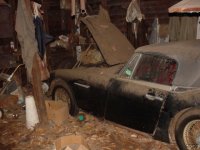Hi everyone,
I'm sure many of you have gotten to the point in their restorations where they need to remove various sections of sheetmetal that are rusted. In the areas where sheetmetal is connected to a frame member it appears that the best way to remove it is to cut it as close to the frame as is reasonable, and then use a grinder to get everything flush and clean.
There are areas however, when sections of sheetmetal overlap one another, and are either spot-welded or connected with interupted welds. What is the best way to separate them in these areas? A case in point is the floor of the trunk area that is connected not only to the cross frame member, but also to the wheel arch, bumper brackets, skirt rail supports, rear bulkhead etc. I guess the question is, do you attempt to separate the connections, or simply cut the metal at the edge of the connections and attach the new piece to the now "doubled-up" piece? This applies to areas of the floor panels, sill pannels, side reinforcements as well.
Not coming from a bodywork background I am not sure what is "kosher" or what is smart! The last thing I want to do is to either create more work or cut away something that I'll regret!
Thanks in advance for your thoughts on this.
Lance
I'm sure many of you have gotten to the point in their restorations where they need to remove various sections of sheetmetal that are rusted. In the areas where sheetmetal is connected to a frame member it appears that the best way to remove it is to cut it as close to the frame as is reasonable, and then use a grinder to get everything flush and clean.
There are areas however, when sections of sheetmetal overlap one another, and are either spot-welded or connected with interupted welds. What is the best way to separate them in these areas? A case in point is the floor of the trunk area that is connected not only to the cross frame member, but also to the wheel arch, bumper brackets, skirt rail supports, rear bulkhead etc. I guess the question is, do you attempt to separate the connections, or simply cut the metal at the edge of the connections and attach the new piece to the now "doubled-up" piece? This applies to areas of the floor panels, sill pannels, side reinforcements as well.
Not coming from a bodywork background I am not sure what is "kosher" or what is smart! The last thing I want to do is to either create more work or cut away something that I'll regret!
Thanks in advance for your thoughts on this.
Lance

 Hi Guest!
Hi Guest!

 smilie in place of the real @
smilie in place of the real @
 Pretty Please - add it to our Events forum(s) and add to the calendar! >>
Pretty Please - add it to our Events forum(s) and add to the calendar! >> 
